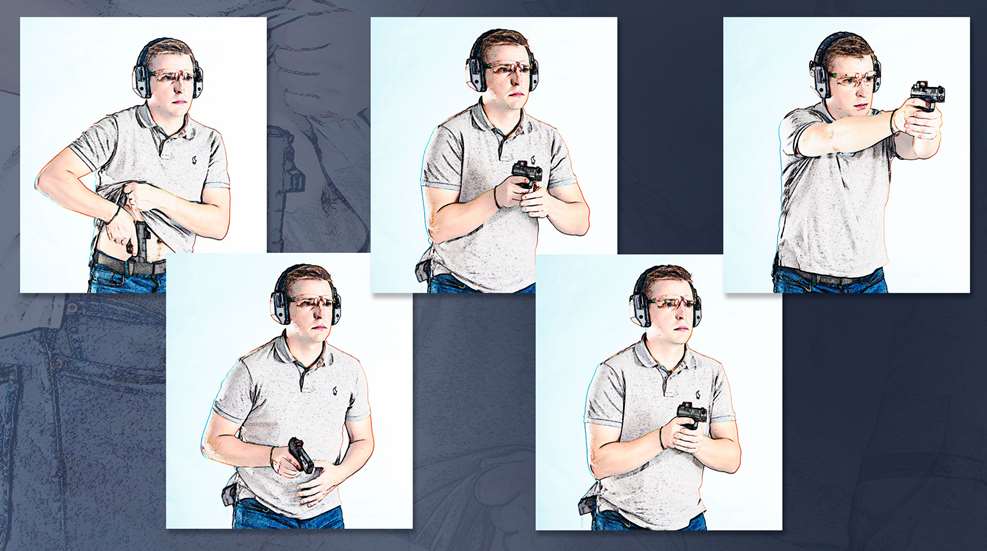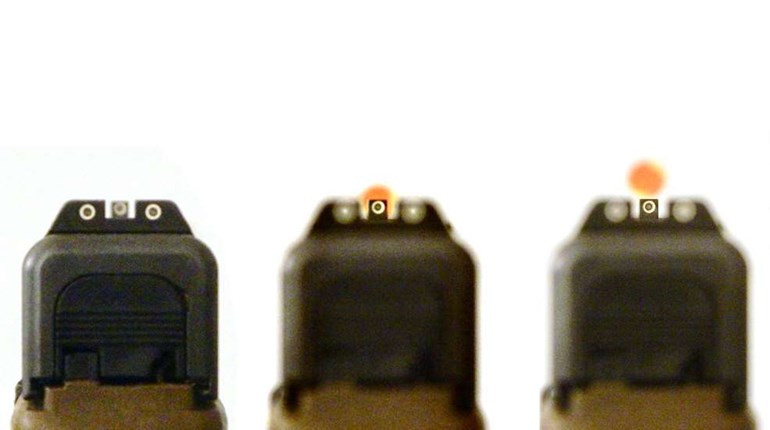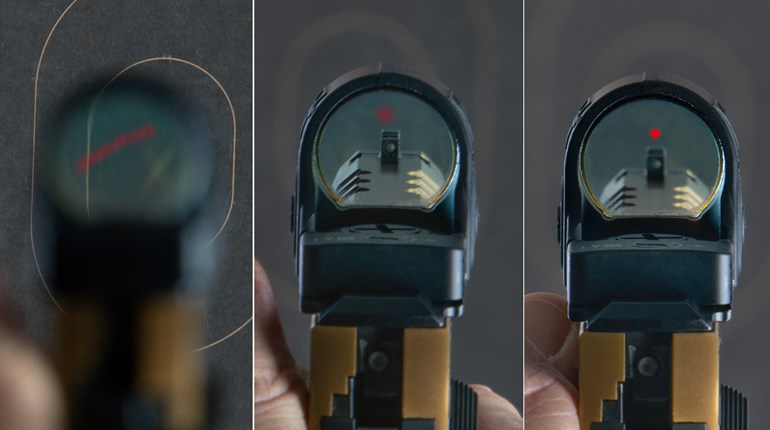
Indexing is an integral component of the pistol draw stroke, serving as the critical starting point where alignment meets stability. It incorporates a progressive series of rapid actions that occur in mere tenths of a second: clearing the carry holster, establishing initial tactile alignment, bringing both hands together, building a signature grip and commencing the precise process of muzzle-target alignment and stability.
However, achieving consistent success in this noble endeavor can often prove elusive. To shed light on the subject, we turn to the insights and recommendations of top-performance shooters on how to master the art of finding index.
The fundamental shooting process, according to multiple-time world champion competitive shooter Rob Leatham, is to “Bring stability to alignment and break the shot without disturbing that alignment.” While this concept may be easy to comprehend intellectually, executing it flawlessly and consistently is a far more challenging task.
To shoot exceptionally well means to be able to perform a single task or tasks on-demand, consistently hitting what you want, when you want and where you want some 80 to 85 percent of the time. Part and parcel of shooting a pistol at such an upper-class performance level is a well-developed draw stroke to facilitate the shooting process starting with the first round from the holster.
Regardless of whether one may be carrying concealed or openly, employing iron sights or carry optics, the goal remains the same: to develop a functionally repeatable, two-hand-supported presentation. This journey commences with retrieving the handgun from the holster while establishing a quality master grip. This initial grip is then married with the support hand, creating a firm and customized hold that provides optimal control of the pistol.
Throughout this process, the trigger is precisely manipulated to develop a well-controlled and perfectly timed press at the top of the draw stroke. It is crucial to maintain both stability and alignment during the press to ensure an accurate shot. Indexing can be further defined as the sub-process responsible for developing alignment and stability, serving as a pivotal waypoint or anchor point throughout the overall pistol draw stroke.
Regarded as paramount to maintaining stability and alignment throughout the shooting process, indexing remains the foundation of rapid and accurate pistol shooting. Without a proper index, shooters are left with no choice but to introduce additional inputs into the process, thereby incurring energy costs and necessitating corrective actions, all of which compromise precious time and vital positional advantage.
Facilitating index, particularly in scenarios that demand rapid deployment and split-second decision-making, warrants a deeper exploration of the intricacies underlying the initial alignment process—namely synchronization.
Just as a modern fighter plane incorporates a digital program linked to an on-board cyber-optics system that directs the guns based on the pilot’s gaze, you must learn to spontaneously synchronize where you point the gun with your own gaze. Achieving efficient eye-muzzle synchronization is a vital aspect of pistol shooting at a master level. As Leatham emphasizes, “Aiming should be a process of confirmation and not a cause for action.” This means that visual confirmation of alignment should require minimal effort and serve as immediate verification rather than as part and parcel of some extended mechanical process. Over-verification of the alignment process consumes precious tenths of a second, which can make a significant difference in real-world gunfights or high-level action-shooting competitions.
The solution lies in cultivating a reliable tactile or kinesthetic alignment component of indexing in a manner similar to that of fighter pilots, where the muzzle consistently aligns with the shooter’s intended target, regardless of speed. In essence, the shooter learns to aim with their eyes, ensuring that the muzzle follows their gaze.
The human body possesses innate biomechanical tools that are often overlooked, but are instrumental in developing precision alignment. These tools are the natural point-of-aim (NPOA—a term originally coined by the late competitive shooter Ron Avery) and proprioception, each playing a unique role in the indexing process.

NPOA is the structural position of your body. Specifically, it is the foundation upon which the alignment process is built. A parallel would be the tracks of a tank or armored personnel carrier. A relevant example of this would be what world-champion Max Michel calls “sectors of fire,” where he teaches you to place your feet and hips in such a position as to neutrally address an array of targets throughout the shooting process, as opposed to twisting your body one direction or the other.
Proprioception is the sense of perception of movement and position of the body—especially limbs—independent of vision. Proprioceptive signals are transmitted to the central nervous system where they are integrated with information from other sensory systems such as visual processing and vestibular processing (signals sent primarily to the neural structures and subcomponents that control eye movement), to create an overall representation of body position, movement and acceleration.
Like a fighter aircraft’s sophisticated targeting system, we humans possess a functional onboard optics program connected to a mechanized “muzzle-driver system.” By utilizing NPOA and proprioception, shooters can develop efficient and time-effective alignment, prior to the apex and top of draw stroke, which is integral to successful indexing. It is through a combination of these two elements that you can consistently place the muzzle precisely where you intend to hit, aiming with your eyes.
Having the ability to kinesthetically (without visual confirmation) align the muzzle precisely at the visual center of any target (aka indexing) is an invaluable skill for any shooter to possess, which leads us to the follow-on logical question: How can one achieve such effective indexing?
According to experienced masters in the field, indexing is primarily about feel, accounting for approximately 80 percent of the shooting process, with the remaining 20 percent being visual confirmation. Given good indexing, the eyes serve to confirm alignment while the trigger is being pressed.
Whether you consider it to be “point shooting” or “sighted fire,” both generalized approaches recognize the crucial role of kinesthetic alignment—where the body aligns itself—during approximately 75 percent or more of the draw stroke process, with visual confirmation serving as the final step.
Mastering index is a priority over any of the other follow-on activities such as hold control and trigger press. In other words, if the shooter has not established proper muzzle alignment, he or she is not ready to fire a round.
Optimizing valuable training time entails developing a keen sense of kinesthetic alignment. Timing the alignment precisely—together with building stability and a quality trigger press—constitutes 90 percent of the shooter’s effort in consistently achieving rapid and accurate hits on demand. Once a shooter has cultivated a heightened sense of swift initial non-visual alignment, they are well on their way to shooting proficiently, as they have become proficient in finding index.
Indexing serves as the bedrock of achieving rapid and accurate pistol shooting from the holster. By exploring the concepts of synchronization, natural point-of-aim and proprioception, shooters can enhance their ability to find index and significantly improve their shooting performance.
Mastering indexing requires a holistic approach that involves the visual, mental and physical aspects of shooting. It demands discipline, practice and an understanding of your body’s biomechanics. By integrating these elements into training sessions, shooters can elevate their skills to new heights.
To enhance the mental aspect of indexing, the consummate professional develops a keen awareness of their body’s natural alignment and proprioceptive feedback. By consciously focusing on these factors during training, shooters can fine-tune their proprioception, allowing them to achieve alignment intuitively and swiftly.
Physical training plays a pivotal role in developing the necessary skills for indexing. It is essential to dedicate time to practice the draw stroke, ensuring deliberate and efficient movements from holster to index. Also, incorporating dry-fire exercises into training routines can also significantly contribute to indexing proficiency. Dry practice involves executing the draw stroke and establishing index without live ammunition. This allows shooters to focus solely on the mechanics of building grip, alignment, trigger control and stability without the distracting elements of live rounds and recoil.
Another valuable tool for enhancing indexing is the use of video analysis. Recording training sessions and mindfully reviewing the footage can provide valuable insights into one’s form, micro-adjustments, good or bad habits and overall performance. Analyzing the video allows you to identify areas for improvement and make any necessary adjustments.

Additionally, seeking guidance from experienced shooters or professional instructors such as masters and grandmasters can offer invaluable insights and personalized feedback. These mentors can provide guidance tailored to your unique shooting needs, wants and aspirations all the while setting challenging but attainable training milestones and performance goals.
Indexing is not just about eventually hitting the target—it is about achieving repeatable success, where shooters consistently hit what they want, when they want and where they want. With dedication, perseverance and a commitment to mastering indexing, you can unlock your true potential to become an elite-performing shooter.
Another aspect that top-level shooters emphasize in developing index is the concept of mental focus and visualization. Before executing the draw stroke and finding index, it is strongly recommended to visualize the indexing process in the theater of your mind.
Incorporating drills that emphasize indexing can be highly beneficial. These drills should focus on developing speed, precision and the ability to quickly establish a quality master grip and incorporating kinesthetic alignment. One such drill is the “indexing drill,” where shooters practice drawing their pistol from the holster and bringing it to the same index waypoint position repeatedly with no wasted motion.
It is additionally worth mentioning that mastering indexing, like mastering any other aspect of shooting exceptionally well, requires patience and persistence. It is important not to get discouraged by setbacks, failures or temporary performance plateaus delaying your progress.
By combining visual, physical and mental focus, subcomponent skill- building drills, and mindful practice, shooters can develop the subconscious go-to skills to consistently find index on demand.
When a shooter approaches training with dedication, seeks guidance from experienced mentors and adopts a mindset of continuous improvement, the result is measurable success. Similarly, with time, realistic practice, discipline and commitment the same shooter can achieve mastery of indexing which will elevate their overall shooting performance to the next level.





































